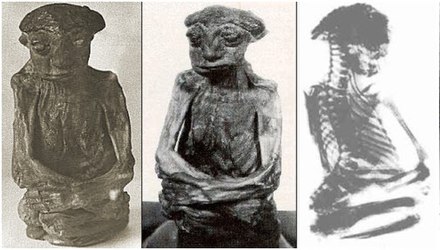
The San Pedro Mountains mummy (known informally as "Pedro") is a mummy discovered in Wyoming in the 1930s and since lost. Scientific analyses have concluded that it is the mummy of a Native American infant that was born with anencephaly, but its small size and unusual physical features led to theories that it was an early hominid or that it was related to legends of little people. A similar mummy that was studied in the 1990s has been nicknamed "Chiquita".
Discovery and description
The mummy that became known as Pedro was discovered in either 1932 or 1934 in the San Pedro mountains in Carbon County, Wyoming by two gold prospectors, Cecil Mayne and Frank Carr. After blasting open a cave, on a ledge inside it they discovered a mummified body in a seated position, approximately 6–7 inches (15–18 cm) tall, weighing approximately 1 pound (450 g). Its standing height was estimated at 17 inches (43 cm). The site may be within the Little Man mining claim, near Pathfinder Reservoir.
Subsequent history and analysis
In 1936, Mayne stated in a sworn affidavit that the mummy was then the property of Homer F. Sherrill and was in the Field Museum in Chicago, which has no record of it. Sherrill, a Nebraskan, exhibited it as an early hominid. It was displayed for years in the window of a drug store in Meeteetse, Wyoming. It was purchased in the 1940s by Casper car dealer Ivan Goodman, who mounted it on a wooden base and enclosed it in a domed glass jar and advertised it as a 65-year-old "pygmy", "preserved as it actually lived". In 1950, shortly before his death, Goodman either lost it in New York or, according to a 1979 article in the Casper Star-Tribune, sold it to Leonard Wadler, who later moved to Florida and died there in the 1980s.
Due to its small size and adult appearance, the mummy was related to Shoshone legends of little people called the Nimerigar, and to non-Native American folklore about "pygmy" Indians. In August 1941, the Milwaukee Journal wrote about it in an article headlined "Did a Race of Pygmies Once Live in America?" In 2005, John Adolfi of Granby, New York, offered $10,000 for the mummy, hoping to use it to cast doubt on the established account of human evolution.
The Casper Tribune-Herald reported in 1950 that X-rays of the San Pedro mummy showed adult vertebrae and teeth, and there were reports of solid food in the stomach and of broken bones, but examinations led by Harry L. Shapiro of the American Museum of Natural History in the late 1940s and by Paul Martin of the Field Museum in 1950 concluded that it was an anencephalic infant; the appearance of a miniature adult was the result of the deformed head. George W. Gill of the University of Wyoming saw the X-rays and agreed with this determination, but the films have also been lost.
Second mummy
In 1994, Gill was interviewed about the San Pedro mummy for an episode of the TV show Unsolved Mysteries along with Eugene Bashor, who was seeking evidence of the Nimerigar. A family in Cheyenne who saw the program then came forward with a similar mummy, 4 inches (10 cm) high, which had been purchased from a sheepherder in the same region of Wyoming around 1929 and was dubbed "Chiquita". X-rays and DNA testing performed at Ivinson Memorial Hospital in Laramie and Denver Children's Hospital confirmed that it was a naturally mummified anencephalic female infant of Native American ancestry, and it was carbon-dated to approximately 1500 or 1700. The family then withdrew access to the mummy.
Both mummies are unique among Wyoming Native American burials in being in a seated position, with the arms wrapped around the legs. Chiquita is also unusual for a Native American in being blonde. The only other known mummy of an anencephalic infant is Egyptian.
See also
- Atacama skeleton
- Alyoshenka
- Koro-pok-guru, small people in Ainu folklore
References
- ^ Hein, Rebecca (November 8, 2014). "The Pedro Mountain Mummy". WyoHistory. Wyoming Historical Society. Retrieved April 21, 2024. According to this source, 1934 is the correct discovery year.
- ^ Nichols, Jake (June 17, 2023). "The Tall, But True, Tale Of A Little Mummy Discovered In Wyoming, Now Lost In Time". Cowboy State Daily. Retrieved April 23, 2024. This source uses the spelling Cecil Main, and cites newspaper reports from 1932.
- ^ Fugleberg, Jeremy (July 6, 2014). "Meet Chiquita: Wyoming's 500-year-old mummy". The Casper Star-Tribune. AP. Retrieved April 21, 2024 – via The Denver Gazette.
- ^ Burke, Brendan (February 3, 2005). "Man offers $10,000 for Pedro Mountain Mummy". Casper Star-Tribune. Retrieved April 21, 2024.
- ^ Fugleberg, Jeremy (September 15, 2014). "Into the cave: Is 'Little Man Mine' site where mummy was found?". Casper Star-Tribune. Retrieved April 21, 2024 – via Billings Gazette.
- "Mummified Pygmy Found". The Waco News-Tribune. UP. December 15, 1934. p. 7. Retrieved April 21, 2024 – via Newspapers.com.
- ^ Sheldon, Natasha (January 4, 2018). "The Truth Behind the Disturbing Mystery of the San Pedro Mountains Mummy". History Collection. Retrieved April 21, 2024.
- ^ Peterson, Christine (October 31, 2010). "Did a mummy prove the legend?". Casper Star-Tribune. Retrieved April 21, 2024.
- Loendorf, Lawrence L.; Nancy Medaris Stone (2006). Mountain Spirit: The Sheep Eater Indians of Yellowstone. Salt Lake City: University of Utah Press. p. 90. ISBN 978-0874808681.
- ^ Loendorf and Stone (2006). p. 189, note 2.
External links
- Description of the Wyoming Mummy collection, 1929-1991, American Heritage Center, University of Wyoming